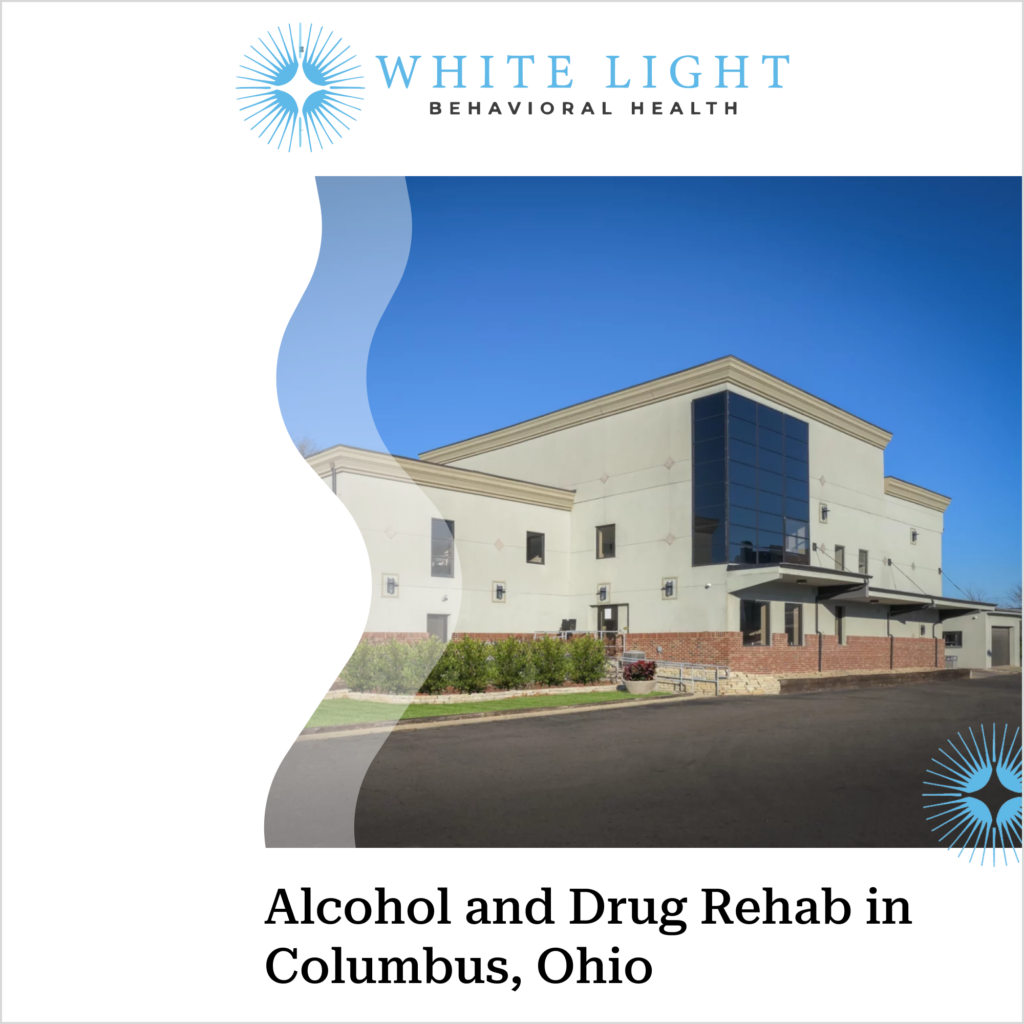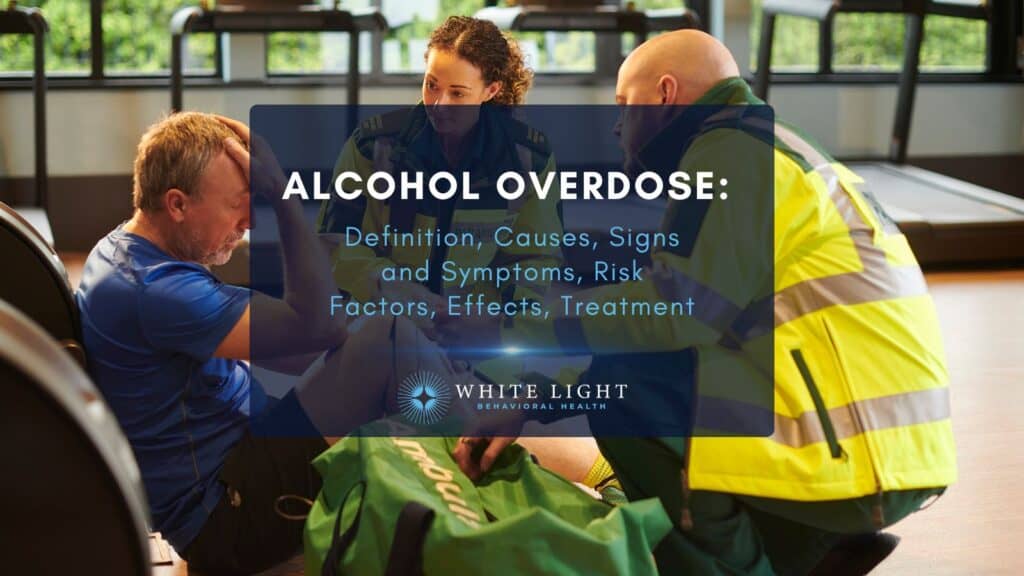Opioid Addiction: Definition, Symptoms, Types, Causes, Effects, And Treatment
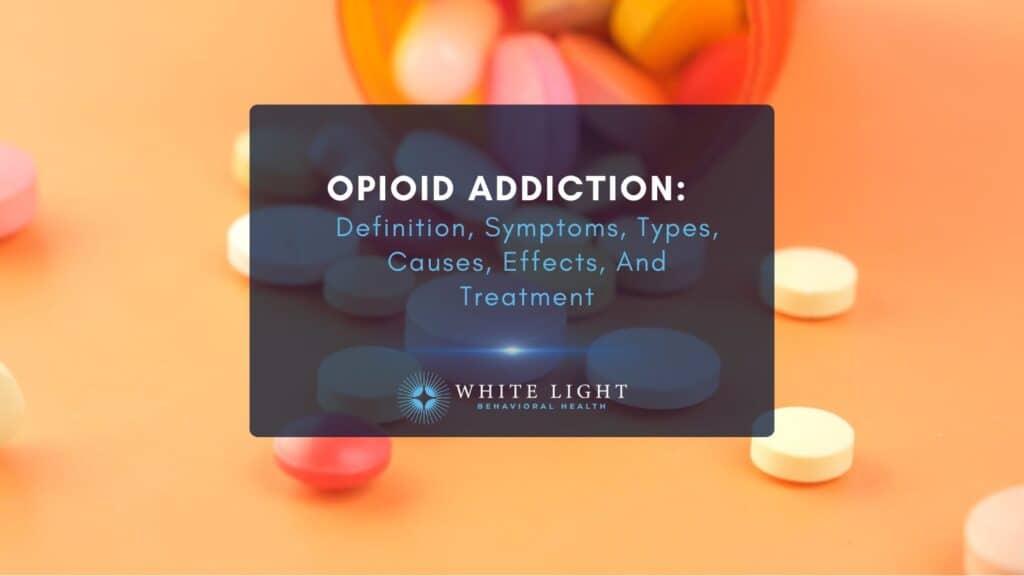
Opioid addiction changes how your brain reacts to pain and reward, creating cycles of dependence that are hard to escape without support. In Columbus, the opioid crisis has reshaped families, hospitals, and neighborhoods over the past two decades. If you’re struggling, this city has resources to help you recover.
According to the Franklin County Coroner’s Office Overdose Death Report (2023), opioids were involved in 81% of unintentional overdose deaths in Franklin County.
You begin treatment at local centers, such as Maryhaven, CompDrug, and Talbot Hall. Most accept Medicaid and offer immediate intake, including detox, therapy, and medication-assisted recovery. Help is available across Franklin County.
What Is Opioid Addiction?
Opioid addiction is a chronic brain disorder caused by repeated use of opioids, which alters how your brain processes pain and reward. It leads to physical dependence and compulsive drug-seeking behavior, even when it results in health, legal, or personal harm. This includes both prescription opioids like oxycodone and morphine, as well as illegal opioids such as heroin and fentanyl.
According to the Franklin County Overdose Fatality Review (2023), over 70% of drug overdose deaths in the county involved opioids, highlighting the urgent need for intervention.
The addiction disrupts normal decision-making, causing powerful cravings and withdrawal symptoms that make quitting extremely difficult without help. In Columbus, the opioid crisis has become a public health emergency.
Did you know most health insurance plans cover substance use disorder treatment? Check your coverage online now.
What Are The Symptoms Of Opioid Addiction?
The symptoms of opioid addiction include physical decline, behavioral disruption, and intense withdrawal patterns. These warning signs appear together and indicate growing dependence that requires urgent care and treatment.

The symptoms of opioid addiction are explained below:
- Physical symptoms: Drowsiness, slowed breathing, unexplained weight loss, and needle marks on arms or legs are common. These signs show the toll opioids take on your body and nervous system.
Long-term use leads to tolerance, making physical health rapidly deteriorate.
- Behavioral symptoms: Lying to loved ones, stealing to obtain drugs, job loss, and isolation become routine. These behaviors damage trust, relationships, and personal responsibility.
More Resources on Addiction:
They are direct results of prioritizing drug use over everything else.
- Withdrawal symptoms: When opioids wear off, nausea, vomiting, muscle pain, anxiety, and insomnia set in. These symptoms begin just hours after the last dose.
Without medical support, they drive immediate reuse.
What Are The Different Types Of Opioids Linked To Addiction?
The different types of opioids linked to addiction include prescription medications, synthetic lab-made opioids, and illegal street substances. Each class carries a high risk of dependence and is widely present in Columbus-area overdose reports.

- Prescription opioids: Oxycodone, hydrocodone, and morphine are prescribed for pain but are frequently misused. Over time, even legitimate use leads to tolerance and dependency.
These drugs are commonly diverted and sold illicitly.
- Synthetic opioids: Fentanyl and tramadol are far more potent than natural opioids. Fentanyl, in particular, is involved in most fatal overdoses in Franklin County due to its strength and unpredictable mixing with other drugs.
- Illegal opioids: Heroin and street-sold fentanyl mixes are widely available and highly addictive.
These substances are unregulated, making dose strength unpredictable and overdose risk extremely high.
What Causes Opioid Addiction In Columbus, Ohio?
The causes of opioid addiction in Columbus, Ohio, include overprescription, long-term pain management, unmanaged trauma, mental health disorders, peer pressure, illicit drug availability, and socioeconomic factors in Franklin County. These factors combine, leading individuals down a path of misuse and long-term addiction.
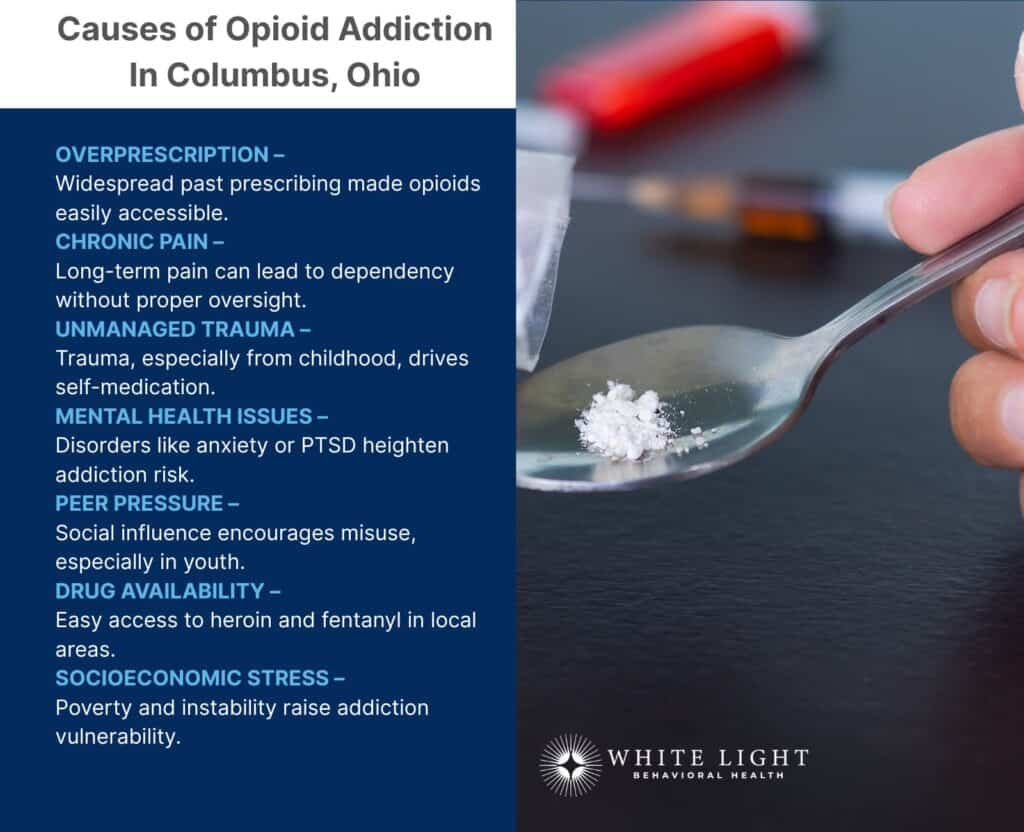
The causes of opioid addiction in Columbus, Ohio, are:
- Overprescription: Years of high opioid prescribing created easy access and normalized long-term use. Many local addiction cases began with a legal painkiller.
- Long-term pain management: Chronic pain pushes patients to seek stronger relief.
Without careful oversight, dependency develops quickly.
- Unmanaged trauma: Physical or emotional trauma, especially unaddressed childhood abuse, increases opioid misuse as a form of self-medication.
- Mental health disorders: Conditions like anxiety, PTSD, or depression co-occur with opioid addiction. Without proper treatment, these disorders intensify cravings and relapse risk.
- Peer pressure: Especially among teens and young adults, social circles normalize the misuse of substances.
Shared access and social acceptance deepen the problem.
- Illicit drug availability: Heroin and fentanyl are widely accessible across Columbus. Law enforcement reports show growing circulation in suburban and urban neighborhoods alike.
- Socioeconomic factors: Poverty, unemployment, and housing instability in Franklin County increase stress and reduce access to early intervention or treatment.
What Are The Health And Social Effects Of Opioid Addiction?
The health and social effects of opioid addiction include severe physical damage, psychological decline, and breakdowns in personal stability. These consequences affect not just your well-being, but your family, livelihood, and community connections.
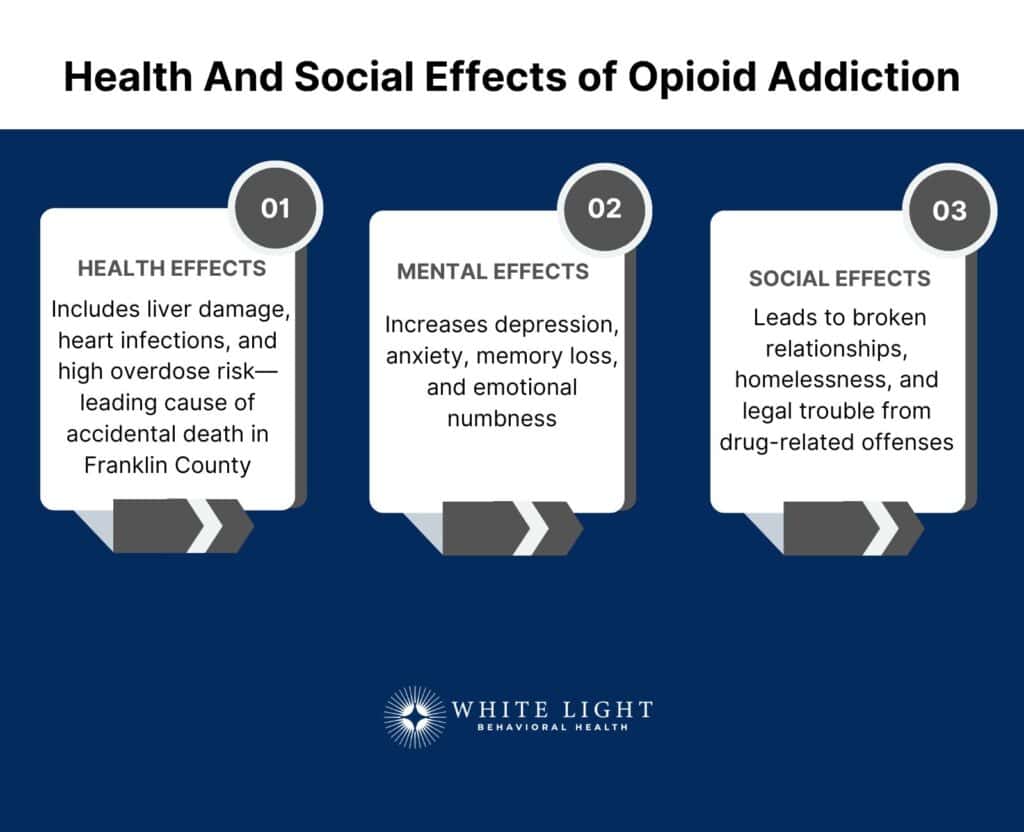
The health and social effects of opioid addiction are:
- Health effects: Liver damage from toxic buildup, heart infections from IV drug use, and high overdose risk are common. In Franklin County, opioid overdoses remain a leading cause of accidental death.
Without treatment, the likelihood of fatal outcomes rises rapidly.
- Mental effects: Depression, anxiety, and memory loss worsen over time. Many users report feeling emotionally numb, unable to concentrate, and trapped in cycles of shame and hopelessness.
- Social effects: Broken relationships with family and friends, homelessness due to job or housing loss, and incarceration for possession or theft are common outcomes.
Addiction pushes people to isolate or break the law in desperation.
How Is Opioid Addiction Treated In Columbus, Ohio?
To treat opioid addiction in Columbus, Ohio, approaches include medication, structured rehab, behavioral therapy, and long-term community support. Each element targets a specific phase of recovery, helping you stabilize, rebuild, and avoid relapse.

To treat opioid addiction in Columbus, Ohio, the approaches are explained below:
- Medication-Assisted Treatment (MAT): Methadone, buprenorphine (Suboxone), and naltrexone are FDA-approved drugs that reduce cravings and block the effects of opioids. Clinics across Franklin County use these medications to support early and long-term recovery.
- Detox, residential, and outpatient recovery program: Facilities for treating opioid addiction offer structured detox followed by inpatient or outpatient treatment.
Residential programs provide 24/7 support, while outpatient care allows flexibility with work and family life.
- Therapy: CBT, motivational interviewing, and relapse prevention therapy help you understand addiction triggers and build healthy coping strategies. These methods are integrated into most Columbus treatment programs.
- Peer support and case management: ADAMH-funded centers connect you with recovery coaches, job placement services, sober housing, and mental health care.
These wraparound supports are key for long-term recovery and stability.
Contact us today to schedule an initial assessment or to learn more about our services. Whether you are seeking intensive outpatient care or simply need guidance on your mental health journey, we are here to help.
Where Can I Find An Opioid Addiction Treatment Center In Columbus, Ohio?
Where to find opioid addiction treatment centres in Columbus, Ohio includes certified clinics, hospital-based programs, and nonprofit recovery centers. You access immediate help through trusted providers offering detox, therapy, and long-term support.
White Light Behavioral Health operates one of the largest addiction treatment networks in the region, with inpatient, outpatient, and detox services available.
Some addiction treatment programs specialize in hospital-based care and dual-diagnosis support. They offer integrated behavioral health and recovery programs, including walk-in access for urgent cases.
These centers are located throughout Franklin County, many offering Medicaid support and sliding-scale fees. Whether you need emergency opioid detox or intensive outpatient counseling, help is available across multiple access points.
If you or a loved one are outside Ohio, and near Pennsylvania, you may consider Innovo Detox, a trusted facility that offers comprehensive detox and medical stabilization services.
Can My Ohio Insurance Cover Opioid Addiction Treatment?
Yes, your Ohio insurance can cover opioid addiction treatment. Medicaid, Medicare, and most private insurance plans in Ohio include benefits for substance use treatment, including detox, medication-assisted treatment (MAT), inpatient and outpatient care, and behavioral therapy.
Under the Mental Health Parity and Addiction Equity Act (MHPAEA), insurance providers must offer comparable coverage for addiction services as they do for physical health care. In Columbus, ADAMH Board-funded centers also support individuals who are uninsured or underinsured by providing services on a sliding scale.
To confirm eligibility, contact your insurance provider or work with intake staff at treatment centers to verify your insurance coverage.
Share This Post
